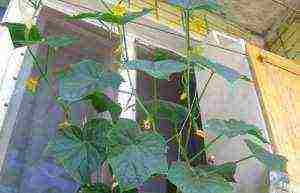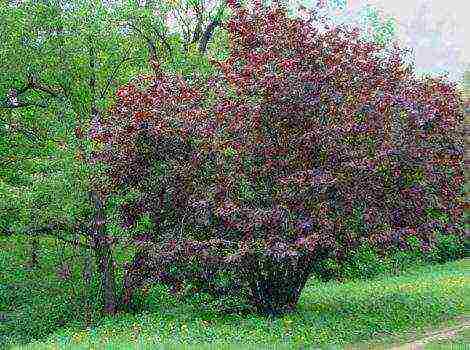Content
- 1 Variety selection
- 2 Soil and seed preparation
- 3 Sowing seeds and picking seedlings
- 4 Greenhouse preparation for tomatoes
- 5 How to prepare the soil in a greenhouse?
- 6 How to prepare plants for planting?
- 7 Schemes for planting tomatoes in a greenhouse
- 8 Planting tomatoes in a greenhouse
- 9 Methods for tying tomatoes
- 10 How to care?
- 11 Harvesting and storage
- 12 Ways of planting a tomato in a greenhouse
- 13 Placing tomatoes in a greenhouse
- 14 Polycarbonate greenhouses: the nuances of growing
- 15 Care rules
- 16 Garter features
- 17 Organization of watering a tomato from planting to harvest
Tomatoes enjoy the well-deserved attention and love of gardeners due to their excellent taste and benefits for the body. Everyone dreams of growing ripe, juicy, huge, fleshy fruits. A reliable method of obtaining a rich harvest is growing tomatoes in a greenhouse.
It has many valuable advantages and benefits:
- Earlier harvest: you can plant tomatoes in the greenhouse as early as April.
- Greenhouse conditions are preferable to open ground: plantings are protected from rain and hail, scorching sun, pests.
- Plants do not require frequent watering and fertilization.
- The yield of tomatoes in the greenhouse is higher: the heat-loving culture feels great indoors and bears fruit well.
- Greenhouse tomatoes last longer.
Experienced gardeners know how to grow tomatoes in a greenhouse and share their secrets.
Variety selection
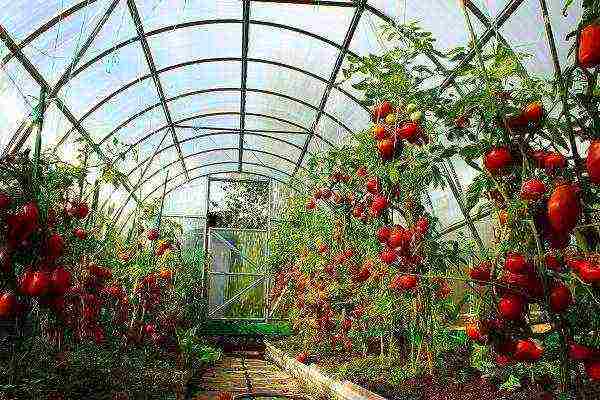
To grow tomatoes in a greenhouse, you need to purchase seeds for greenhouses. It is important to decide in advance on the purpose of the harvest, because vegetables for sale, canning or salads differ in properties.
All varieties of tomatoes can be divided into 2 types:
- Determinant - short, suitable for small greenhouses (large and sweet pink "Spring of the North" and "Masha Doll", large ultra-resistant to weather conditions "Bourgeois" and "Azhur").
- Indeterminate - better tolerate weather conditions, grow in height as long as they allow, suitable for large greenhouses (fast-growing "Russian Happiness", sweet salad "Major", leading variety "Sprut").
Soil and seed preparation
All stages of growing tomatoes in a greenhouse depend on the quality of the soil: from planting to ripening. Planting seeds in ordinary soil is the most common mistake of inexperienced and novice gardeners. The soil in the greenhouse must be rich in organic and mineral substances. It is worth paying attention to a mixture of soil, peat and sand in equal quantities.
Mix well, pour it with a nutrient solution:
- 25-30 g of potassium sulfate;
- 10 g of carbamide;
- 25-30 g superphosphate;
- 10 liters of water.
Before planting, the seeds are treated with Fitosporin solution (2-4 drops are diluted in a glass of water and soaked for 2-3 hours). The bright color of the seeds in the package indicates that they have already been processed. Seed washing is not required.
Sowing seeds and picking seedlings
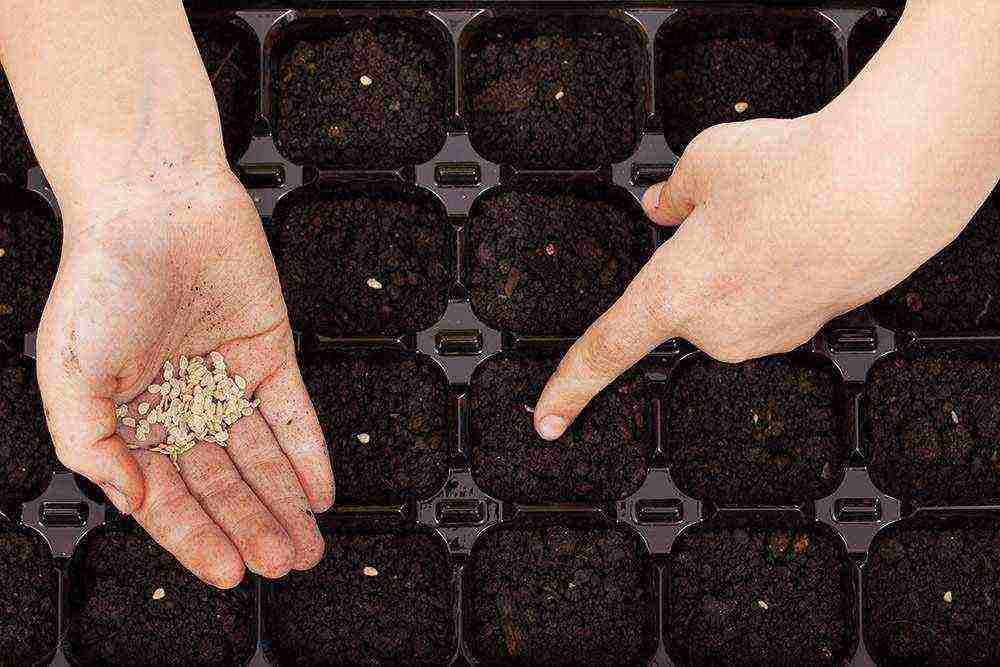
Seeds for seedlings are sown in boxes 5-8 centimeters high. Having poured the soil, it is tamped a little, grooves are made with a depth of 1-1.5 cm and watered with water. The seeds covered with soil are placed in a lighted place at room temperature.
7 days after germination, the seedlings need a transplant. The hardened plant roots become cramped in the box. Before diving, all the seedlings are carefully examined: by this time they should have at least 2 leaves. Taking out each plant with a lump of soil on the root, carefully transplant it into a more spacious container.
Greenhouse preparation for tomatoes
This is an important step in ensuring normal plant growth and disease protection. It is recommended to start preparing the greenhouse for growing tomatoes in the fall. After carefully removing all plant residues, disinfect the future residence of the tomatoes.
Timber framed greenhouses are fumigated with sulfur. Mixed with kerosene, it is laid on metal sheets located along the entire length of the greenhouse. All cracks in the walls are recommended to be well caulked. The ignited mixture is left to smolder for 5 days. Sulfur helps to get rid of mold, fungi, infections and harmful insects.
Sulfur cannot be used for greenhouses with metal parts in the structure: it is corrosive. In this case, the soil, walls and ceiling are sprayed with a solution of chlorinated lime. For its preparation, 400 g of bleach is diluted in 10 liters of water and insisted for 4-5 hours.
The treated room is tightly closed for 2-3 days. After disinfection, the greenhouse is ventilated and thoroughly cleaned from the inside with brushes. Metal parts are poured with boiling water, wooden parts - with a solution of copper sulfate.
How to prepare the soil in a greenhouse?
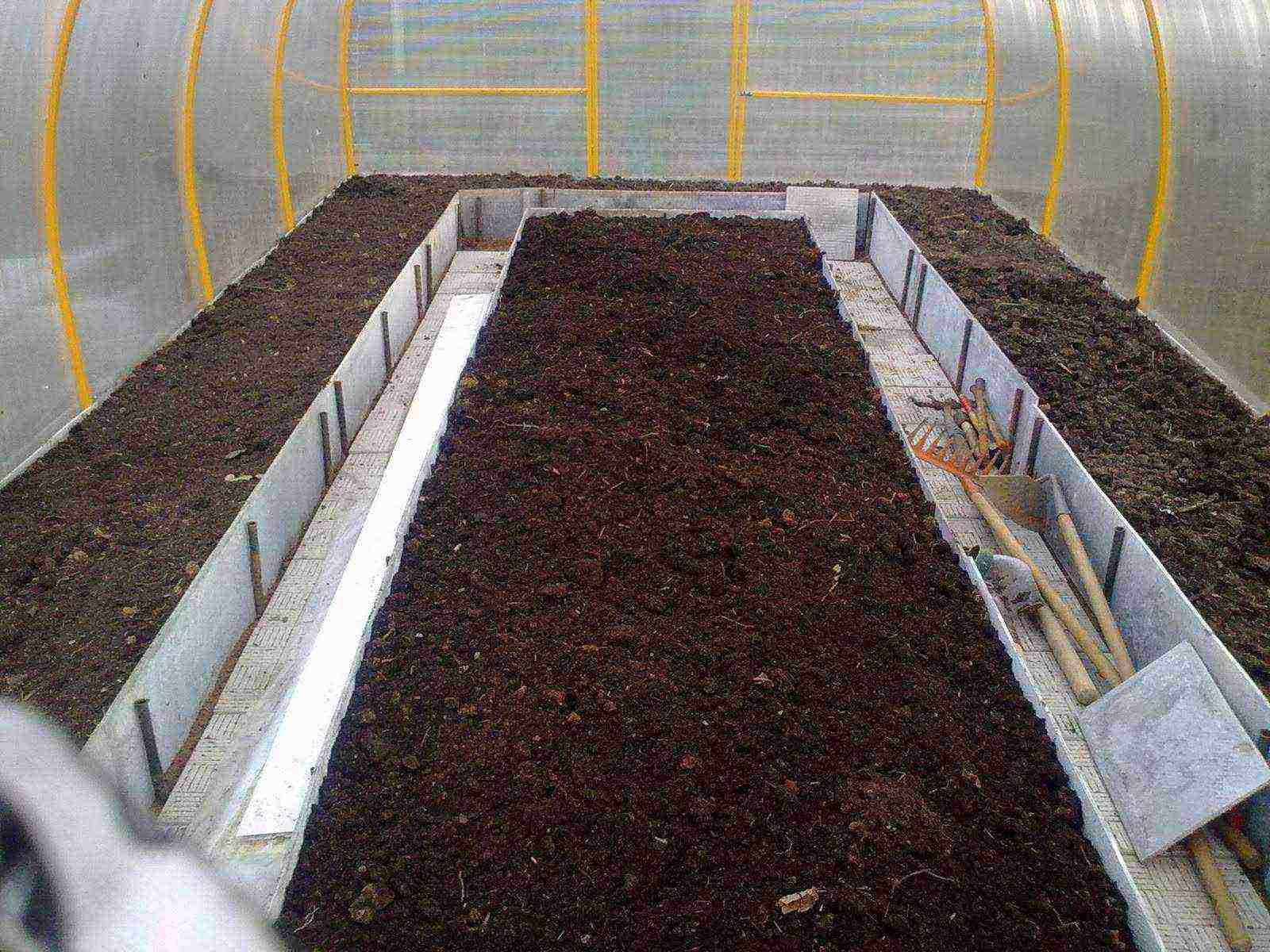
Greenhouse soil needs to be completely changed every 5 years. If this is not possible, they are limited to autumn disinfection with garden lime, copper sulfate solution, Bordeaux liquid or dolomite flour (at the rate of 50 g per 1 sq. M). You can treat the soil with boiling water.
Due to the extremely high susceptibility of tomato roots to cold, elevated beds are used for planting them. Experienced gardeners advise to insulate them additionally: having completely removed the ground from the greenhouse, cover the area under the tomatoes with needles or straw about 10 centimeters thick. Lay a ball of compost about 10 centimeters high on top of them, and then return the earth back, pouring it 20 centimeters high.
In the fall, an organic fertilizer is introduced into insufficiently nutritious soil from equal shares of peat and humus at the rate of half a bucket per 1 sq. M. The ash mixed with sand can be laid on top of organic matter (1 liter per 1 sq. M). Then the soil is covered with straw.
Later, the fallen snow is brought into the greenhouse and laid on top of the straw. Snow serves as a reliable protection against freezing of the soil in winter and good moisture for it in spring. To create comfortable living conditions for tomatoes, in the spring, compost or complex fertilizers are added to the soil and the soil is dug up.
How to prepare plants for planting?
Tomato seedlings are best planted in greenhouses in early May. The night temperature at this time is quite low for seedlings, so it is better to cover the greenhouse with a double film, not forgetting to make ventilation on all sides.
The number and month of planting have a direct impact on the healthy growth of tomatoes. Tomatoes are planted in heated greenhouses in warm spring around April 29-30, in greenhouses with a double cover without heating - May 5-10, in greenhouses without heating - May 20-25. The dates may be a little later, if the spring does not please with warmth.
The optimum soil temperature in the greenhouse for tomatoes is + 10-15 ° С, air - + 20-25 ° С. The north-south layout of the rows provides natural light. Tomatoes should not be planted for the second year in the same place: their yield will be much lower.
Schemes for planting tomatoes in a greenhouse

To obtain the maximum yield of tomatoes, it is recommended to correctly plan the place in the greenhouse. The size of the greenhouse, the variety of tomatoes, the methods of plant formation determine the planting pattern.
Experienced gardeners offer the most successful proven options:
- For undersized early ripening varieties: staggered order in 2 rows with an interval between rows of 50-55 cm, distance between bushes 35-40 cm and formation of 2-3 stems.
- Determinant and standard types: the gap between the rows is 45-50 cm, between the bushes - about 25 cm (up to 10 plants per 1 sq. M).
- Tall giants: staggered planting with a row spacing of 75-80 cm and between plants 55-60 cm (1-stem formation) or 70-75 cm between rows (2-stem formation).
The scheme for planting seedlings of different varieties of tomatoes in a greenhouse received very good reviews, which provides a rich harvest all year round.
According to this plan, tomatoes are grown in 2 rows:
- Takes up space at the edges of the greenhouse near film or glass. Designed for growing determinant early ripening (35-40 cm between bushes), which are formed into 1 stem.
- Located at the inner passage. Designed for planting tall giants with a distance of 60 cm between plants, which form into 1 stem. Having retreated 10 cm to the south, in the same row, superdeterminant standard species are planted with giants with an interval of 25 cm between the bushes, which are formed into 1 stem and pinched after the appearance of the second shoot. Standard varieties have time to give a crop before the giants ripen.
The correct formation of the beds is of great importance for the successful cultivation of tomatoes in the greenhouse. Close them up about a week before planting tomatoes. The beds look like mounds 30-40 cm high and 60-80 cm wide, located at a distance of about 60 cm.
Planting tomatoes in a greenhouse
It is optimal to plant plants in a greenhouse at the age of 1.5 months. The root system of tomatoes by this time is already well developed. It is recommended to plant noticeably elongated seedlings a little lower than the rest, removing the lower leaves. For planting tomatoes in a greenhouse, an evening of a warm spring day is best.
Before planting, the tomatoes are watered abundantly. A handful of humus or a mixture of a handful of wood ash with 1 teaspoon of superphosphate is laid out in small dug holes with a diameter of 10-15 centimeters and poured with a weak solution of potassium permanganate (for one nest - 2 liters).
Tomato bushes are transplanted into a greenhouse along with an earthen clod. For convenience, the well is filled with water and the plant is placed in the resulting mud. Overgrown seedlings are placed at an angle, sprinkling part of the stem with soil.
It is recommended to compact the soil around the planted plant a little and sprinkle it with soil, mulch on top. To protect tomatoes from late blight, the planting is sprayed with Bordeaux liquid (100 g per 10 l of water) or copper oxychloride (40 g of copper per 10 l of water).
After planting, the seedlings are not disturbed for 5-6 days, allowing them to get used to new conditions. After a week, the soil is slightly loosened, improving the flow of oxygen to the roots. Before planting, it is recommended to install a garter for each bush so as not to damage the roots of the plants after planting.
Methods for tying tomatoes
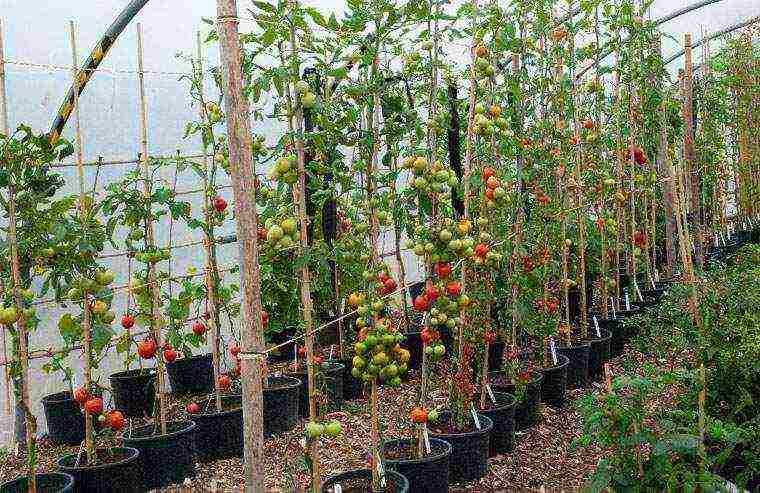
- Pegs. This method is suitable for medium-sized varieties. The pegs will be metal rods, rebar trimmings, wooden stakes, thin plastic tubes. Their length should exceed the expected height of the bush by 25-30 cm (the depth of driving into the ground). The pegs are placed next to the stem, they wrap the tomato trunk with a garter and tie it to the support. As the bush grows, this procedure is repeated.
- Tapestries. They are used for giants of indeterminate species, the height of which in greenhouse conditions can reach 5-6 meters. Maximum saving of space in the greenhouse with the help of trellises allows planting up to 3-4 tomato bushes per square meter. On long stakes driven along the ridge, a strong twine or steel wire is pulled every 35-40 cm.
The stem and branches of a growing bush are tucked in between a stretched twine using the braiding method. The trellis method allows you to leave side shoots for development, maximizing the yield.
How to care?
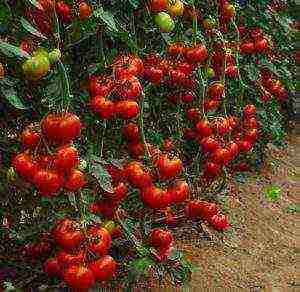 Proper greenhouse tomato care includes airing, watering, and garters.
Proper greenhouse tomato care includes airing, watering, and garters.
The first time the plants in the greenhouse are watered only on the 10th day after planting with water at room temperature, then watering is continued every 4 days.
During flowering, plants are watered more often, during fruiting - more moderately 2-3 times a week. It is recommended to water the plants at the root in the morning.
When the tomatoes reach a height of 15-20 centimeters, they are stepson once a week, carefully cutting off the lateral processes. To protect against diseases 6-7 times a season, plants are sprayed with a tincture of 40 g of chopped garlic in 10 liters of water.
Tomatoes are not afraid of drafts, so all the doors and vents of the greenhouse can be safely opened 2 hours after watering. On a sunny day, the temperature in the greenhouse should not rise above + 26 ° C, and on a cool day it should not drop below + 20 ° C.
10 days after planting, the first feeding of the plants is carried out, then organics and minerals are applied once every 10 days. To obtain fruits with a sweeter taste, boric acid is added to the dressing (1 g per 1 l of water).
Deterioration in the appearance of plants indicates a lack of substances necessary for growth and development:
- pale weakened leaves, bad inflorescences - nitrogen;
- slow growth, blue crumbling leaves - phosphorus;
- yellowing leaves - calcium.
During the flowering period, tomatoes need mineral feeding (1 liter per square meter):
- 10 liters of water;
- 40 g of phosphate fertilizers;
- 25 g nitrogen;
- 15 g of potassium.
In the fertile period, organic matter is used for feeding tomatoes: 2 liters of ash are poured up to 10 liters with hot water, insisted, 1 bottle of iodine and 15 g of boric acid are added. After insisting a day, the mass is diluted with cold water (a liter of the mixture per bucket of water) and the tomatoes are poured at a rate of 1 liter per bush.
Harvesting and storage
There is no delay in the tomato harvest. The fruits must be removed until the daytime temperature drops below + 8 ° C, and the night temperature drops to 0 ° C. It is ideal to pick tomatoes in the morning when they are most elastic. The collected fruits are sorted immediately. Brown ones are placed in 2-3 layers in wooden boxes. Added to them 2-3 fully ripe tomatoes accelerate ripening, releasing ethylene.
Early and mid-season tomato varieties grown in a greenhouse are not stored for long. Longer shelf life for fruits placed in wooden boxes with a mixture of birch sawdust and peat chips. Some gardeners practice freezing harvested tomatoes, which are briefly immersed in cold water before eating. You can store frozen tomatoes under a layer of snow in wooden boxes.
Keeping tomatoes in the refrigerator is not recommended due to the detrimental effect on their aroma. Ripe fruits are stored at room temperature away from direct sunlight.
Not everyone, even the most experienced vegetable grower, can grow good tomatoes. By learning how to care for tomatoes in a greenhouse, you can increase yields per square meter and get rid of serious diseases that the crop is susceptible to.
Greenhouse arrangement
Growing tomatoes in a greenhouse is possible in any region and allows you to get an earlier harvest, increasing its duration. But a certain microclimate is formed in the greenhouse, due to which it is harder to grow tomatoes in one place every year.Therefore, part of the work on caring for tomatoes is done long before they are planted and begins with the arrangement of the greenhouse.
Greenhouse for growing early tomatoes
A tomato needs a greenhouse with high ceilings, covered with a material that has high light transmission and maintains a certain temperature regime. It is easier to build a greenhouse made of polycarbonate, this material has rather high characteristics. The greenhouse will need to be equipped with air vents. This is due to the fact that bacteria accumulate in a closed environment, to which tomatoes are very susceptible. To protect plants from a number of diseases, high-quality ventilation is necessary.
Important! Tomatoes are sun-loving plants. It is necessary to take this into account when building a greenhouse. It should be located in an unshaded place and be made of a transparent material that allows a large percentage of sunlight to pass through.
A bed before planting tomato seedlings
When choosing the size of the greenhouse, you need to take into account at what distance the plants will be planted and leave the beds of the order of 60-90 cm and paths of 30-40 cm. Soil preparation begins in autumn. First, you need to dig up the ground and apply fertilizers to saturate the soil with useful substances:
- peat, rotted manure, humus - introduced before winter;
- straw - added if desired to make the bed loose and warm;
- superphosphate, urea, ash - applied in spring;
- potassium permanganate solution - just before planting.
Variety selection
There are a wide variety of tomato varieties. Choosing the best option for landing in a greenhouse, you need to focus on the following properties and characteristics:
Study the characteristics of the variety before planting it
- Greenhouse grade.
- Low to medium height. Tall varieties are rarely planted in a greenhouse, since in closed ground they can significantly exceed their vegetative size.
- Early and mid-season. Late-ripening varieties are rarely planted in a greenhouse, since it is precisely the acceleration of the ripening process that is desirable to achieve with this method of planting.
- Pollinated or self-pollinated. It is better to choose based on the possibility of providing free access for insects to the greenhouse.
- Hybrid. They are more resistant to diseases, differ in early ripening and the duration of the fruiting period.
Growing seedlings
In order for the bushes to be strong, it is worth following the rules for growing seedlings. Seeds need to be prepared before planting:
- Warm up for 3 hours at a temperature of about 50 °. This procedure will "wake up" the seeds, which will accelerate germination and promote faster growth of seedlings. Higher temperatures can kill seeds.
Processing tomato seeds before planting in the ground
- Treat with manganese solution (1 g per 250 ml) for 15 minutes. This will avoid some diseases.
- Treat with growth stimulants for 12 hours. In addition to special preparations, you can use ordinary wood ash, which performs similar functions.
- Soak the seeds. In this case, boric acid can be added to the water. The stage lasts 12 hours.
- Hardening at a temperature of + 1 °. Place the seeds in the refrigerator for a day, sprinkling occasionally with water.
Planting is carried out in special pots at the end of February (some varieties - at the beginning of March). The soil for seedlings is prepared in a week: combine earth, peat and humus in equal shares. Superphosphate and wood ash are used as fertilizers. Shallow (1-2 cm) grooves are formed in the boxes every 5 cm. They need to be watered with sodium humate, and the seeds should be planted every 1-2 cm. Having sprinkled the seeds with soil, there is no need to water them. It is better to leave the boxes in a dark place until the moment of germination. During this period, the temperature should be 18-20 °. After the emergence of seedlings, you need to rearrange them in a bright, warm place (22-25 °). To speed up the emergence of sprouts, the boxes can be covered with plastic wrap.
Seedlings of tomatoes
Seedling care is carried out in this order:
- After the sprouts appear, maintain the temperature at 16 ° during the day and 14 ° in the evening.
- It is enough to water it once a week (at the root). High humidity during this period is not required, since it is possible to pull out seedlings.
- After the formation of the third leaf, the seedlings dive: each seedling is transplanted into a separate pot. The soil is prepared in the same way and flavored with a potassium solution. Weak seedlings are discarded.
- Temperature regime after a dive: 20 ° during the day, 18 ° - at night. Watering - once a week.
- Two weeks later, the seedlings are fed with nitrophos.
- After 25 days, a second pick is made into larger pots. The care is similar.
- After 15 days, top dressing is performed with superphosphate and potassium sulfate. After another two weeks, the procedure is repeated.
For seedlings, it is very important to observe the temperature regime in the room.
At the time of planting, the plant should have about 10 leaves.
Important! Re-picking is necessary so that the plants do not stretch out, but a thick, strong trunk forms.
Greenhouse landing
Before planting, it is worth treating the prepared soil with a solution of potassium permanganate. It is necessary to plant seedlings in pre-formed beds, with holes every 30-40 cm. Even if the variety is not tall and "bushy", they should not be planted at a shorter distance. Plants will not receive enough light, and insects will be difficult to access. For tall varieties, a 50 * 50 cm scheme is recommended, in a checkerboard pattern. It is not worth leaving a long distance between the bushes when planting. It is believed that the 80 * 80 cm scheme will lead to a decrease in yield, since the bushes will branch more strongly and all nutrients will be spent on the formation of the bush, and not on the development of ovaries and fruits.
The plant is ready for transplanting into the greenhouse when about 10 leaves have appeared on it.
At the time of planting, it is necessary that the temperature in the greenhouse reaches 22-25 °. It cannot be allowed to decrease, especially at the time of flowering. Otherwise, the pollen of the tomato will not ripen and the fruits will not be tied.
It is better to plant plants in pots so as not to disturb the root. Putting it in the hole, you will need to sprinkle it with earth, press down and water.
It is extremely important to properly care for the tomatoes, which begins immediately after planting in the greenhouse. It consists of watering, feeding, pinching, forming a bush, maintaining an optimal level of lighting and humidity.
Watering and humidity
You need to water the seedlings every 5-7 days with not cold water. Tomatoes do not like high humidity, especially in a greenhouse, where it is fraught with the development of pathogenic bacteria. Do not allow liquid to get on the leaves, especially on sunny days, but try to water at the root. It is better to choose a time for this when the sun is less active (in the evening).
Scheme: organization of a drip irrigation system for tomatoes in a greenhouse
Tomatoes tolerate short periods of drought well, but do not tolerate dampness and moisture. You can find out that there is not enough moisture on the ground - it will begin to crack, and on the leaves - they will curl. To prevent dampness, the greenhouse must be opened. When the outside temperature has reached similar to a greenhouse, it can be opened in whole sections for the whole day. This will also give insects easy access to pollinate the flowers. But in the early stages, airing should be done only on warm days and for a short time, since the culture is susceptible to frost.
The optimum humidity inside the greenhouse for tomatoes is 65%. It is worth monitoring the indicator for the normal development of the ovaries. At a higher value, the pollen will roll and fall off, and at a lower value, it will not be able to germinate.
Top dressing
Tomatoes must be properly fertilized, alternating mineral and organic substances. In each period, certain fertilizers are needed:
- 14-16 days after planting, you need to feed the bushes with ammonium nitrate and every week - a mixture of superphosphate, potassium and urea.
Feed your plants regularly to help them grow faster in the greenhouse
- During the flowering period, fertilize with manure and nitrophosphate.
- Every two weeks, but no more than 3 times, apply potash fertilizers or manure.
You can use cow or bird manure. If possible, alternate feeding organics and minerals. With an excess of organic fertilizers, tomatoes begin to "fatten", the bushes give a lot of lateral shoots, stepchildren, which inhibits the development of fruits.
Bush formation
Already on the 14th day after disembarkation, it is necessary to begin examining the bushes for the possibility of the appearance of stepchildren. They usually grow when the first cluster of buds appears. Care for tall and undersized tomatoes in this case is somewhat different:
- High grades (over 180 cm). They differ in the presence of a large number of ovaries, therefore, it is not worth leaving stepchildren to form additional stems. All appendages are removed systematically (every 1-2 weeks). On the main stem, about 10 brushes can fully develop.
- Average. (150-180 cm). Can be shaped into two stems. To do this, one of the lower stepsons, the strongest, is recommended not to be cut off. Leaves will begin to grow on it, fruits will set and new stepchildren will appear. You need to look after the second stem in the same way, but you should not leave more than 5-7 ovaries on it.
- Low (up to 150 cm). They differ in a small number of additional processes. To increase their yield, it is worth leaving 1-2 additional stems, so that about 4-5 brushes are formed on each.
Shape the tomato bush according to its variety
For undersized hybrids, which do not have stepchildren at all, care consists only in pinching off the top, after the formation of a sufficient number of ovaries. Such varieties usually have shorter ripening periods and are distinguished by large fruits.
Important! If, when pinching off the stepson, you leave a small process, this will significantly slow down the process of the appearance of new stepsons.
After removing the stepson, a small penny should remain
When tearing off stepchildren, you can use scissors or pruning shears if it has reached more than 5 cm, so as not to damage the stem. It is not worth starting pinching so that the processes do not absorb the nutrients necessary for the formation of flowers and fruits. If at some point a "false" tip began to appear on the bush and it began to bifurcate, you need to remove one of the processes. After reaching the required number of ovaries on the stem (up to 10 for bushes formed into one stem, up to 4-5 for additional stems), the top must be pinched off. This is necessary for the bush to stop growing. A large number of fruits will still not be able to fully form: they will be small and ripen for a long time.
Caring for tomatoes and feeding plants in the greenhouse: video
How to grow tomatoes in a greenhouse: photo
How to care for tomatoes in a greenhouse correctly, how is the correct planting of seedlings or seeds carried out, growing fruits all year round, what is the technology, secrets and features of growing in order to get a good harvest in the end? Such questions concern many gardeners and gardeners, in particular, beginners.
There are certain features and scheme of planting and growing tall and hybrids. Caring for tomatoes in a greenhouse involves the correct and timely watering of the bush, picking, pinching the bush, top dressing (often peat, humus, compost or mullein, which are introduced into the ground, are used for this).
Content
Also, tomatoes in a greenhouse should be treated for diseases after planting, seedlings should be sprayed against pests, and seedlings should be dived. If you follow the advice, recommendations for cultivation, in the future you can get a good harvest all year round.
How seedlings are grown
In order to grow good, productive tomatoes in a greenhouse, there are certain tips, especially growing ones. The technology of growing tall varieties is different from growing and planting low-growing ones. Caring for tall varieties is also different from other species. To grow good and productive greenhouse plants, it is worth choosing the right seeds for your seedlings.
Usually, tomatoes are grown for seedlings in pots, wooden or plastic boxes, peat cups.
How to plant planting material, it is checked, seeds that are empty or with signs of disease are rejected. Before planting, they are kept in a solution of diluted manganese for a quarter of an hour, after which they are washed with warm running water. Then they spread it on a saucer with a napkin soaked in moisture.
They must be constantly wet, so water is periodically poured onto the napkin, cover the saucer with a lid so that the moisture does not evaporate so quickly. This procedure will help the seeds swell faster for seedlings.
A day after swelling, seeds for seedlings can be planted in the ground. Fertile soil for seedlings consists of humus, turf. It also includes peat. All soil components for growing seedlings are applied in equal proportions.
Tips and the correct technology for growing seedlings indicate that the swollen seeds are lowered into containers, into which soil or peat was previously poured.
- In each glass or other container, two or three grains are dipped into the ground, lightly tamped into the ground.
- The distance between them is one centimeter.
Observing such a distance between the bushes, in the future, the seedlings will be able to grow and develop freely without touching or shading each other (growing seedlings at a certain distance between the bushes is an important stage in order to get a good harvest all year round).
After planting in the ground is completed, future seedlings and the beds themselves are abundantly irrigated with water from a sprayer. About a month and a half after planting, the deciduous mass of the bush is actively growing.
- At this stage of growing seedlings, in order to avoid stretching, the optimal temperature should be maintained - 19 degrees during the day and 15 degrees at night.
- Water the seedlings several times - after the sprouts appear, 14 days after germination, and the third time a few hours before the seedlings will be planted in the ground.
This is how the seedlings are properly prepared for planting in the ground, it will allow you to grow good, productive tomatoes.
For 10 days, as the seedlings will be planted in the ground in the greenhouse, it must be sprayed with a special compound in order to strengthen the inflorescences and grow a good harvest. When planting tomatoes in bushes, you need to observe a certain distance between the bushes, at the correct distance between them, you can harvest a good harvest all year round.
How seedlings are planted
The greenhouse or greenhouse for tomatoes should be well ventilated. In the room, the vents should open or the roof should rise. You need to ventilate the structure daily. To properly grow seedlings all year round, the room must be well lit.
If there is not enough sunlight, you need to make a system of artificial lighting and heating. It is possible to grow fruitful tomatoes, both tall and hybrids, only under favorable conditions, the greenhouse needs to be ventilated, illuminated and heated.
The peculiarities of planting seedlings are to make the beds correctly. To correctly make the beds during planting, you should take into account the width of the room itself. For 10 days as the planting will be carried out, you need to make beds, observing certain conditions, tips, the distance between the bushes (tall and hybrids, they need to be planted at different distances between the bushes).
The height of the beds is also observed.How much height should be? The height of the holes for tall plants is at least 70 centimeters (if you grow only tall plants, as the growing diagram says), if you grow not tall, the height should be about 40 centimeters.
This optimal height will allow you to grow a good harvest. The width scheme for tall and not tall ones is also observed, respectively - 60 and 90 centimeters. The scheme provides for the passage between the holes. How many? About half a meter.
Fertilization conditions for the soil when planting
When planting in a greenhouse, the preparation of the premises itself and the preparation of the soil are carried out in advance. The bottom layer in the greenhouse should create drainage, then fertile soil is poured. Drainage is necessary for aeration in the root system (the root system must breathe, water must not stagnate), for it you can take sawdust, crushed stone, to which peat is added.
How many centimeters should the drainage layer be? It all depends on the length of the seedling root.
The higher the seedling, the thicker the drainage layer. Before planting seedlings in the ground, the soil is pre-fertilized:
- Humus, peat, ash are brought in - if the soil is clay or loamy;
- If the main part of the soil is peat, humus, sod, wood ash or sawdust are added to it;
- Regardless of whether peat is an integral part of the soil or not, potassium sulfate and superphosphate are also added to the ground before planting seedlings.
After fertilizing, the soil is well dug up before planting the seedlings. Immediately before planting tomatoes, the soil is irrigated with a solution of potassium permanganate. Instead of potassium permanganate, you can spray the ground before planting with the Zaslon preparation (for the prevention of diseases and pests of the soil and the tomatoes themselves).
How many centimeters should the seedlings be before planting in the ground? The height of the bush should be up to 30 centimeters, if the seedlings are tall, the height will accordingly be greater, while the distance between the bushes is different. It is necessary to plant the plant carefully so that the root system is not injured, the earth is lightly sprinkled, and the earth is also slightly compacted gently.
To properly plant and grow tall tomatoes, the scheme is as follows:
- Bushes with tall varieties are usually planted through one in each subsequent row;
- Bushes with tall or not tall tomatoes should be planted in a row, as long as the distance between them is required - at least half a meter, at this distance you can grow good, productive tomatoes.
If the distance between the bushes is respected, tomatoes often grow in branches, unnecessary inflorescences and leaves grow on them, this significantly slows down the ripening of fruits. After the seedlings are planted, do not water the soil for 14 days, this will prevent the bush from pulling out.
Such secrets of experienced gardeners allow you to grow large, good-yielding tomatoes (seedlings also love such a component as peat, it is recommended to apply it as often as possible).
Proper care after disembarkation
When planting at the correct distance, trellises are installed near the beds, to which the seedlings, shoots and branches of the culture are subsequently tied. This will allow you to grow large and productive fruits.
Seedlings are planted in the greenhouse in spring, so on sunny days, the structure needs to be often ventilated. If the seedlings are growing too densely, they must be dived until inflorescences appear on them.
This will make it possible to grow fruitful bushes all year round, large and good fruits. Growing also involves pinching (leaving one stepchild to grow quality material). Extra and unnecessary stepchildren should be removed, leaving only large flower brushes. On one bush, the conditions allow the finding of one large stepson (this is what the growing instructions say).
To carry out pollination in greenhouse conditions, the seedlings are gently shaken.For fertilization to be effective (and a good harvest in the future), the soil must be moistened immediately after pollination.
The conditions allow the use of various growth stimulants, this will make it possible to grow plants faster, they not only grow quickly, but also begin to bear fruit earlier, bringing a good harvest all year round.
It is necessary to spray with stimulants before the formation of fruits. Spray against diseases and parasites before flowering (this is how the growing instructions say, remember the distance between plantings).
To grow a good harvest all year round, proper watering of the soil is an important factor. The land should not be left dry, but it should not be allowed to overmoisten the soil, moisture should not stagnate (this will allow you to grow fruitful bushes, as the instructions for growing).
The cultivation scheme assumes regular airing of the room (all year round), especially during the period when the tomatoes begin to bloom. Condensation accumulated on the walls of the structure negatively affects the development of plants all year round, the seedlings do not like high air humidity after watering (this is stated in the growing diagram).
To grow strong seedlings, to get a high-quality harvest in the future after planting, you should follow certain rules when planting plants and use peat. The soil must be well prepared, preparation consists in digging up the soil, and preparation also involves the introduction of fertilizers.
Seedlings love peat in the soil, this must also be taken into account. Growing involves planting at the correct distance so that each bush can grow and develop freely. Such growing conditions make it possible to grow fruitful tomatoes all year round, to plant only high-quality planting material in the spring.
The property of tomatoes is known - thermophilicity, therefore it is not always possible to bring the fruits of tomatoes to full maturity in the open air. Using greenhouses to grow vegetables is ideal for those who live in temperate regions. But there are peculiarities of tomato agricultural technology in greenhouse conditions. Knowing them will help you achieve high yields of delicious tomatoes.
Ways of planting a tomato in a greenhouse
There are two methods for planting tomatoes in a greenhouse. It is useful to have an idea about each of them.
Correct planting with seeds in the ground
Despite the fact that the air temperature in the greenhouse rises during the day thanks to the bright March sun, it is cold there at night. To plant seeds, you need them temper in advance... To do this, after soaking, the material is placed either in a refrigerator or in warm water. The seeds that have hatched are now ready to grow.
It is important that the temperature does not drop to minus five degrees at night.
Special heating of an enclosed space will help to avoid this. It happens:
- biological with the help of fresh manure;
- stove;
- electric.
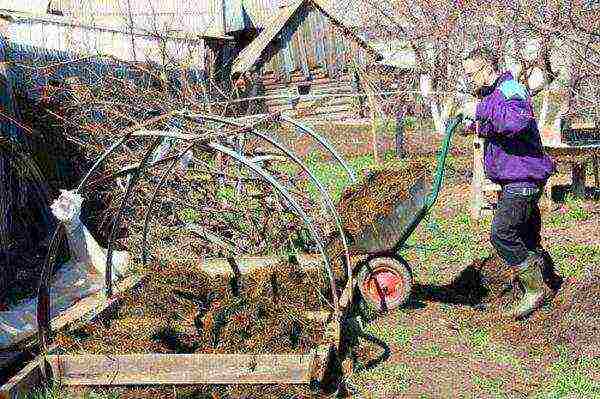 You can sow seeds in February by filling the greenhouse with hot manure.
You can sow seeds in February by filling the greenhouse with hot manure.
Having filled the greenhouse with a shovel of hot manure at the end of February, you can sow seeds. They will have enough heat until mid-May. Manure is heated by sprinkling with hot water, sprinkling with quicklime.
Shelters of walls made of mats in two layers keep warm well. Three days later, the manure is leveled, soil is poured onto it. You can plant tomato seeds in it. The accelerated growth of hardened seedlings allows them to bear fruit a month - one and a half earlierthan in the garden beds.
How to plant tomato seedlings
It is easier to grow tomatoes in seedlings. There are some nuances of planting seeds and emerging sprouts. In the spring they sow tomatoes for seedlings in greenhouses not earlier than March 20... Once she reaches sixty days of age, you can plant or plant her in a permanent place in the room, for example, on a windowsill.
For seedlings air temperature is important - it should reach eighteen degrees during the day, sixteen at night. It is worth watering the seedlings three times in the first month. Water is used warm, well-separated. When the first shoots appear, they switch to watering up to once a week.
Plant the dived seedlings in place, preparing a layer of earth of 17 centimeters, then adding it twenty centimeters. The soil should consist of equal parts of humus, sod land with the addition of a small amount of river sand.
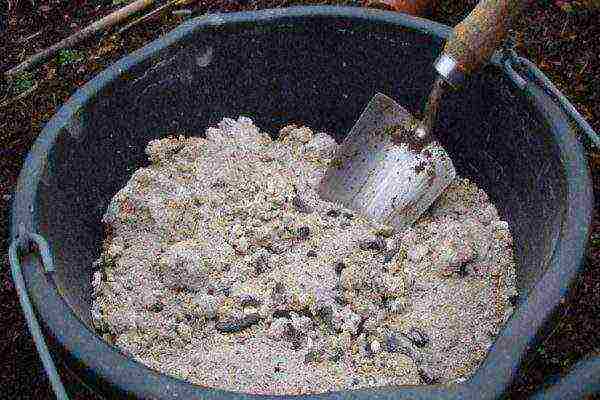 Before planting seedlings, wood ash is added to the hole.
Before planting seedlings, wood ash is added to the hole.
Before planting, fifty grams of wood ash is placed in each prepared hole or furrow, thoroughly mixed with the ground. Planting tomato sprouts is carried out deeply, reaching the bottom of the shelves.
Elongated seedlings - planting features
With a lack of lighting, excessive watering, the seedlings become long.
Because of the thin stem, tomato seedlings often break, therefore, when transplanting, a number of rules must be observed:
- A cloudy day or in the morning is suitable for planting seedlings. with low temperature air.
- The long stem fits into the planting hole in a ring. You can lay the kusutik horizontally, leaving a stem on the surface, which is no more than forty centimeters long, or, conversely, leaving most of it underground.
- Tear off the lower leaves and stepchildren on the stem.
- Carefully pour the soil into the hole, trying not to damage the shoots.
- Drive a peg next to it, to which tie seedlings.
- At the end of the procedure, the bushes are watered.
If at the beginning of growth the elongated sprouts lag behind their counterparts in development, then after the formation of new roots, the tomatoes will become stronger.
What is a square-nested method of disembarkation
When planting seeds or seedlings of tomatoes in the ground, use the square-nesting method, which will make caring for tomatoes easier. And for plants it will be better to pass absorption of nutrients... With this planting, there will be enough light for each bush.
The scheme for planting a tomato in a square-nesting way is as follows:
- In one socket 70x70 centimeters place two or three plants of standard and determinant species.
- Early ripening tomatoes are enough two for one nest.
- With medium and late ripening - one plant each. With an increase in the nest by twenty centimeters, you can plant two tomatoes each, slightly reducing the planting density.
After landing, it is necessary ventilate more often, which will avoid the spread of fungal diseases indoors.
 To prevent the appearance of fungus, the greenhouse must be thoroughly ventilated.
To prevent the appearance of fungus, the greenhouse must be thoroughly ventilated.
The best timing for planting a tomato
The correct planting time for a tomato plays an important role in obtaining a good harvest.
The timely arrival of spring with stable weather is the main condition for planting a vegetable crop in addition to proper grooming and watering. For the seedling growing method, planting it in an unheated greenhouse is carried out in the first decade of May. In this case, it is necessary to additionally insulate the walls of a closed room, covering it with mats.
In regions with warm climates, heated greenhouses are prepared for the tomato in March, and with moderate, including Western Siberia, Novosibirsk, Krasnoyarsk - in the end of April... The spring sun will give the tomatoes enough warmth and light to grow.
Placing tomatoes in a greenhouse
In accordance with the choice of tomato variety, greenhouse designs also plant young bushes:
- For indeterminate tomatoes, a staggered arrangement of bushes is chosen. They need to be placed in rows with a distance between them. no more than eighty centimeters... The distance between plants will be half a meter when formed in one stem, and in two - seventy centimeters.
- Determinate species need row spacing in half a meter... The remoteness of the bushes from each other is thirty centimeters to those that are grown in two or three stems. It is reduced to a rate of twenty-five units if one stem is formed.
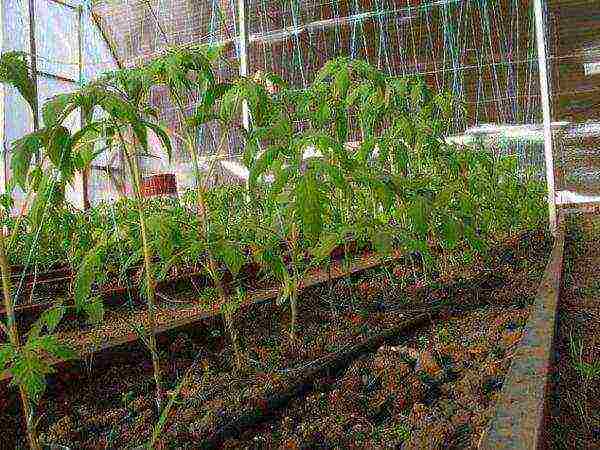 When planting in one stem, the distance between bushes can be reduced to 25cm
When planting in one stem, the distance between bushes can be reduced to 25cm
It is important to follow the rules for placing tomatoes, otherwise they will not have enough nutrients, moisture, light and air.
Overcrowding of plantings leads to diseases in tomatoes. Growing strong and vigorous plants becomes difficult when they thicken.
Optimal bed width
The device of the beds depends on the area of the greenhouse. With a standard area of 3x6 beds, a place is suitable along the wall... High-quality lighting of the bed will be with its direction to the west.
The height of the soil in relation to the track is made in 40 cm... The width of the bed can be 60 or 90 cm... For full care, you will need a track a little less than half a meter wide.
Care must be taken to arrange the necessary equipment and to provide sufficient track width. This will allow for proper care of the tomato beds.
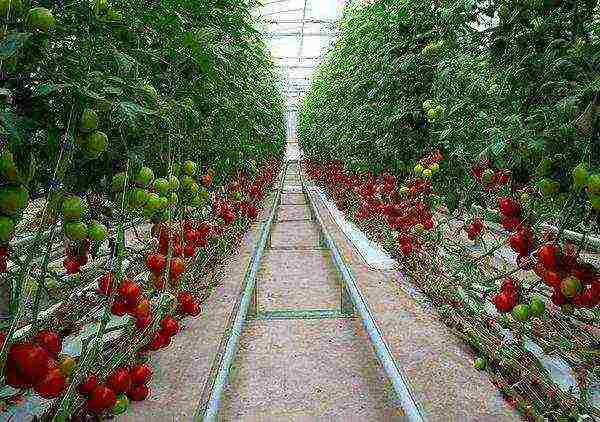 It is necessary to think in advance about the sufficient width of the paths in the greenhouse.
It is necessary to think in advance about the sufficient width of the paths in the greenhouse.
Features of the location of undersized and tall varieties
For the proper placement of tomato bushes, you can use the following recommendations:
- Planting in two rows is suitable for tall varieties, since they leave two stems in the nest. And the distance between the rows reaches eighty centimeters.
- Disembarkation would be ideal in the middle rooms of tall varieties, On the sides - undersized. When ripe at different times, the tomato can be harvested continuously.
- With the modest size of the greenhouse, the tall ones arrange a bed in one row on the sides, and the undersized ones - in two rows in the middle of the room.
It is necessary to think over the location of different varieties of plants and choose an approach to planting in advance.
Polycarbonate greenhouses: the nuances of growing
The advantages of polycarbonate greenhouses are:
- small mass;
- long service;
- low thermal conductivity;
- high light transmission.
Growing garden tomatoes in these greenhouses is easy.
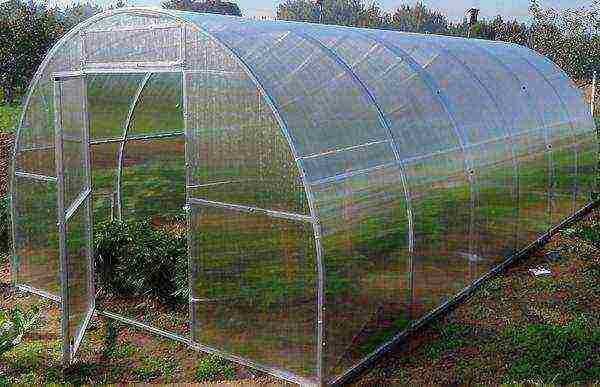 Polycarbonate greenhouse
Polycarbonate greenhouse
Agrotechnics of tomatoes in a polycarbonate greenhouse: planting dates, distances between bushes
In the first days of May you can start planting seedlings in a polycarbonate greenhouse. At this time, the seedlings already have a strong root system, a thick stem, one or two flower clusters.
After hardening the seedlings in the open air for two weeks, they are sprayed with a solution of boric acid. This will prevent the buds from falling off. Before planting, the two lower leaves on the shoots are removed. The plant layout is the same as in ordinary greenhouses.
Disembarkation step by step
Before planting a tomato in a greenhouse, it is necessary to add humus, peat, phosphate and potassium fertilizers to the prepared beds. For soil disinfection it needs to be processed - sprayed with a solution of potassium permanganate or treatment with the Zaslon preparation is performed.
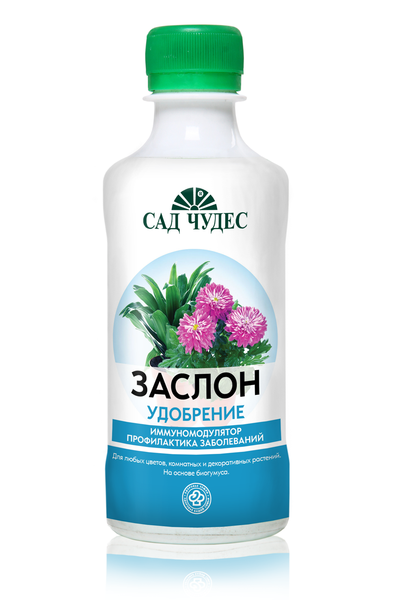 For disinfection of the soil, treatment is carried out with the Zaslon preparation
For disinfection of the soil, treatment is carried out with the Zaslon preparation
Seedlings are placed in the prepared holes using the square-nesting or tape-nesting method. The depth of the holes is no more than twenty centimeters. For better assimilation of phosphorus, which is necessary for tomatoes for proper development, wood ash is added to the holes.
The seedlings are immersed until the first true leaf.
Depending on the moisture content of the soil and air in the greenhouse, the seedlings are watered two - three liters per bush... Tomatoes planted in the evening in cloudy weather will take root well.
Planting care requirements
For active growth of a tomato in a polycarbonate greenhouse, it is necessary to create conditions:
- air temperature in 22 degrees, but not more than 25, soils - over fifteen.
- aeration for the flow of fresh air into the room;
- maintaining the humidity level at around 70 percent.
- to water as it dries the top layer of the soil;
- top dressing with the introduction of monopotassium phosphate and potassium nitrate weekly along with watering;
- pollination with shaking the bushes during the flowering period.
Compliance with all the rules for caring for tomatoes in a polycarbonate greenhouse will lead to constant fruiting of the bushes.
 Watering is done as the topsoil dries up
Watering is done as the topsoil dries up
Growing secrets
It's no secret that you can get high yields of tomatoes in the early stages only by growing them in a greenhouse. In addition to this plant in protected ground less attacked by pestsdo not suffer from disease.
The correct operation of the ventilation duct of the greenhouse is ensured as follows: they thoroughly and regularly wipe the walls of the structure. If the place for the greenhouse installation is chosen correctly - well lit, without shading from the side of trees, buildings, then the light will freely penetrate into it.
Before starting the preparation of tomato seedlings for the greenhouse, it is necessary to select such plant varieties that can grow well in greenhouse conditions.
Preparation and disinfection of soil for future beds obligatory, the health of plants depends on it.
Insects will help in pollination of a tomato. You can attract bees, bumblebees, wasps to the greenhouse with sweet fermented compote, kvass.
Spraying with copper sulfate, boiling water increases the resistance of tomatoes to diseases.
Care rules
Care for tomatoes grown in greenhouses, is different from those that grow in the open field.
Features of courting after planting seedlings
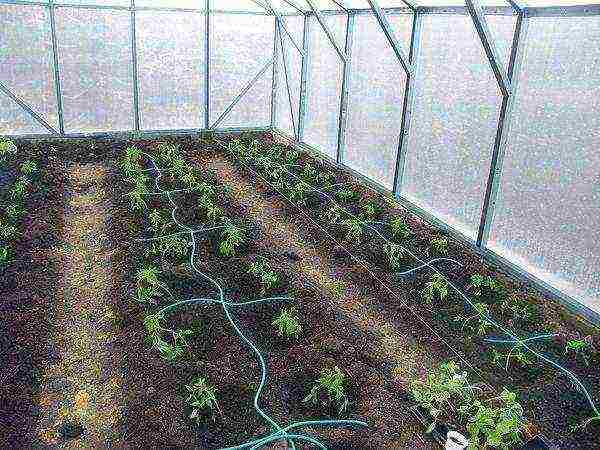 To prevent drops from falling on the leaves, drip irrigation is perfect.
To prevent drops from falling on the leaves, drip irrigation is perfect.
For young seedlings, it is important to carry out timely watering, the introduction of optimal doses of fertilizers. A week after planting, the plants are watered. Before flowering, watering is carried out with a break of five days. One bucket of warm water per square meter. Watered at the root, trying to prevent drops of moisture from getting on the leaves. Drip irrigation is also suitable.
Two weeks after planting, carry out feeding bushes with mullein, diluted in water for five hundred milligrams - ten liters, add ten grams of ammonium nitrate, fifty grams of superphosphate, fifteen grams of potassium chloride. The next time after the appearance of flowers, the ripening of the fruit should be treated with fertilizers, doubling the amount of minerals when dissolved in a bucket of water.
What is the difference between greenhouse and greenhouse care
Greenhouses are used for a smooth transition of seedlings from home to open ground... Therefore, the timing and rules for planting tomatoes are the same for both greenhouses and greenhouses.
The choice of a place for a greenhouse and a greenhouse should take into account the level of occurrence of groundwater.
It cannot exceed two and a half meters from the soil surface. So that the soil is not sprinkled from the walls of the greenhouse, they are sheathed with boards. Greenhouses are installed on the southern slopes of the site, this will avoid flooding the territory.
 The greenhouse must be installed on the south side of the site
The greenhouse must be installed on the south side of the site
Feeding methods
It is necessary to feed tomato bushes during budding and fruit formation... Fertilizers or compost are added every month between the rows. Fertilizers are purchased in specialized stores, taking into account the importance of the presence of a large amount of nitrogen in them.
Suitable for feeding mullein, bird droppings, mineral supplements. All types of fertilizers are diluted in a bucket of water and applied after watering the bushes. A bucket of mortar is enough per square meter.
When to ventilate
In order for the plants to receive more air and light, it is necessary to open the greenhouse doors for ventilation. The procedure will help reduce high temperature and humidity... High humidity parameters, heat will not allow fruits to set, pollination will slow down.
In hot weather, it is necessary to arrange a draft by opening the greenhouse on both sides.
Airing is included in the prevention of late blight.In fine dry weather, you can leave the greenhouse open overnight.
How to plant for a good harvest
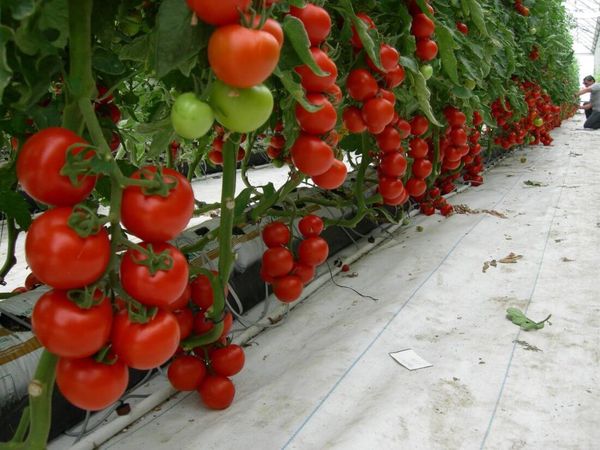 A big harvest is the dream of every gardener
A big harvest is the dream of every gardener
Getting a large harvest of juicy fruits is the dream of every gardener. For this it is important comply with the landing dates vegetables when the temperature in the greenhouse is maintained at twenty-five degrees Celsius at night.
Tomatoes will grow better in polycarbonate greenhouses. But in hot summer, it is enough to hold the bushes under the film for the first time. Although it is in the greenhouse that tomatoes are harvested earlier and more often.
Variety selection tomato is important. There are tomatoes that yield rich harvests in the greenhouse, but they do not ripen well in the open field. It is best to choose hybrids that do not require pollination and produce excellent fruit. The resistance of hybrid species to diseases that prevent an increase in yield is also noted.
How soda helps
For prevention of powdery mildew baking soda is used on tomatoes. To prepare the solution, take four liters of water, add a tablespoon of soda and half a teaspoon of liquid soap. Stir well, spray the tomato bushes in the greenhouse once a week.
Garter features
Most types of tomato require the stalks to be tied to the pegs. The garter of plants is carried out taking into account the variety... It is optional for early maturing and undersized varieties.
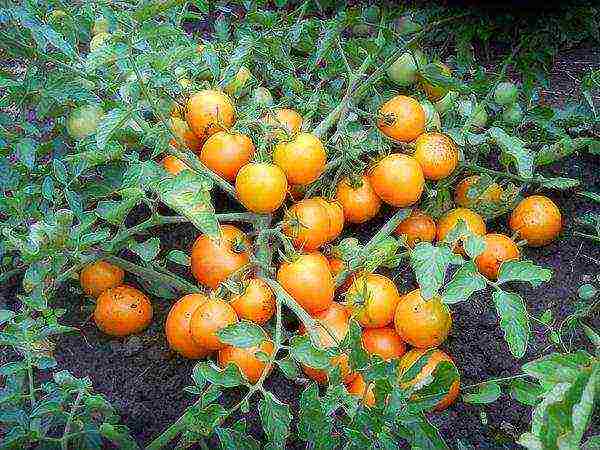 Low-growing varieties of tomatoes do not need a garter
Low-growing varieties of tomatoes do not need a garter
How to tie up a greenhouse
There is no difference in the garter of plants in a polycarbonate greenhouse and a simple one.
Wire, strong fishing line, harsh thread, thin twine are never used as a material. Such materials will easily cut the stem. Fabric strips two to three centimeters wide are the best choice. Before the procedure, they must be disinfected by scalding them with boiling water or washing them with laundry soap.
Pegs are driven in near the tomato above the stems by 30 cm and loosely tie the stem to them.
Another way to tie up is the arrangement of trellises. Stakes are driven in along the beds, pulling a wire, a strong cord between them in several rows. During the growth of tomatoes, they are tucked into a wire or the brushes are hung on hooks.
Garter of short and tall varieties
It is better to tie undersized varieties individually to the pegs... But such a garter will not withstand the brushes of ripe fruits of tall species. Therefore, for tall tomatoes, it will be better to erect trellis... With this method, the successful growth of stepchildren is possible.
Do I need a node
The central stem of the plant is wrapped with a strip of material with hands, crossing the ends with a figure eight or twisting, tied to a support. It is not necessary to make a strong knot, otherwise it will be difficult to remove it. It is enough to tie it in the form of a bow. After the growth of the stem, the first bandage is removed by tying it higher.
Hang on a trellis or tie up - which method is better
Both options are convenient for tomato growth. Tie brushes of tall tomatoes to the top of the trellis or hung on hookslocated at the top. In both cases, the fruits continue to grow successfully no matter how they are suspended.
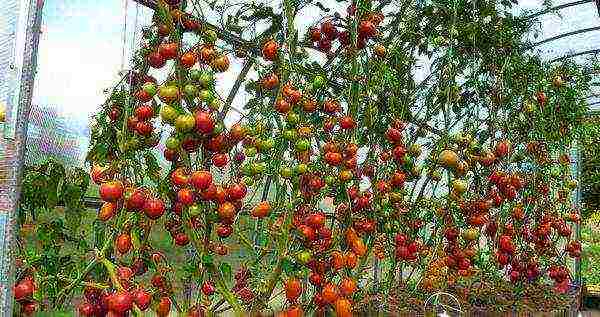 Tall tomatoes are hung on hooks
Tall tomatoes are hung on hooks
What can be used as a peg
It is convenient to prepare individual pegs or sticks for tying up tomato bushes. They will last for several years.
You can replace them:
- scraps of reinforcement and metal fixtures;
- metal rods;
- thin plastic pipes;
- wooden slats.
The choice of a peg and how many of them should be in order to tie up a tomato depends on the power of the plant stem.
Organization of watering a tomato from planting to harvest
Watering play important role in caring for planting tomatoes in a greenhouse.
Frequency of first watering
After planting, it is necessary to take a break in soil moisture, which will allow strengthen the root system young plants. Three days later, up to two liters of water is poured under each bush. Then the number of procedures is increased.
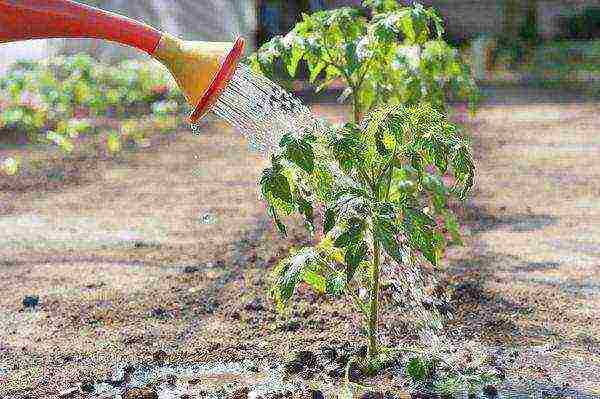 After strengthening the roots, up to 2 liters of water is poured under each bush
After strengthening the roots, up to 2 liters of water is poured under each bush
Morning is considered the best time to water. And then the greenhouse is opened for ventilation. Watering will be sufficient once - twice a week.
Features of watering in a polycarbonate greenhouse
In the greenhouse, tomatoes are often watered in the flowering phase, doubling the amount of water. The best option would be a hydration break. in two days... After the formation of ovaries, a decrease in the frequency of watering begins. In this case, weather conditions are also taken into account. In wet summer, it is enough to water the plants once every two weeks.
Increased watering will lead to an increase in the green mass of the plant, to a decrease in the fruiting of the tomato.
How to water tomatoes
High yields in the greenhouse are obtained if irrigation is carried out with water at a temperature of 20-25 degrees... Many people add a tablespoon of table salt and a glass of wood ash to a bucket of water. By pouring half a liter of solution under each bush, you can harvest a good harvest of sweet, fleshy tomatoes.
Water the tomatoes, adding a little grass mass to the water.
Organization of drip irrigation of plants
 Drip irrigation can be organized independently from a hose and a dropper
Drip irrigation can be organized independently from a hose and a dropper
Using homemade drippers to water tomatoes is important for hydration root area plants. In this case, water is supplied in small portions.
For the device of this method of irrigation, hoses with a diameter of 1.5 cm... Droppers or drip tapes are attached to them. The hose is connected to a tap or dipped into a container of water. The system is laid along the landings, sprinkled lightly with soil. Through a tape or drip, water will flow directly to the root system of the vegetable crop.
How seedlings are watered
Since the future harvest depends on the state of the seedlings, you need to know how to water it correctly. Young growth can quickly die from a lack of moisture. When pecking seeds, reduce the frequency of watering by making break for two days.
In case of severe dryness, you can spray the soil with a spray gun.
As soon as the first leaves appear, they observe the drying of the top layer of the soil. Only then is watering or spraying done. Two or three days before the pick, the soil is softened by watering and the first top dressing. The sprouts are then more easily removed from the ground.
Four days after transplanting the seedlings, watering begins, bringing it up to once a week... The amount of moisture can be increased if the intensity of the sun's rays increases, which leads to the drying out of the soil.
There are some peculiarities for planting tomatoes to grow them. It is important to know all the nuances of how to care for them in ordinary greenhouses and polycarbonate greenhouses in order to get high yields of tomatoes.

